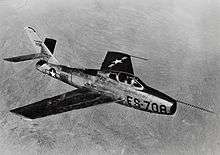General Electric J73
| J73 | |
|---|---|
 | |
| Cutaway of a J73 at the NMUSAF | |
| Type | Turbojet |
| National origin | United States |
| Manufacturer | General Electric |
| Major applications | North American F-86H Sabre |
| Number built | 870 |
| Unit cost | $145,000 |
| Developed from | General Electric J47 |
| Developed into | General Electric J79 |
The General Electric J73 turbojet was developed by General Electric from the earlier J47 engine. Its original USAF designation was J47-21, but with innovative features including variable inlet guide vanes, double-shell (inner and outer) combustor case and 50% greater airflow was redesignated the J73. It was only used in the North American F-86H.
Design and Development
An engine, uprated from the J47, was required for the F-86H. The mass flow was increased by relocating accessories from the centre of the compressor inlet to the underside of the engine. This allowed a reduction in blade hub diameter, which together with an increase in tip diameter, gave a bigger area for air to enter the compressor. The area through the combustion chambers also had to be increased.[1] This was done by replacing the multiple individual chambers with a single annular casing with individual flame tubes or cans known as cannular.
The pressure ratio was increased and variable inlet guide vanes fitted to prevent low-RPM problems (rotating stall/blade flutter)[2] with the higher design pressure ratio. A 2-stage turbine was required.[3]
A low boost (10% at take-off) afterburner was fitted. It was known as a tailpipe augmentation (TPA) system.[3]
Variants

- J73-GE-1
- J73-GE-3
- 9,200 lbf (40.92 kN) for the North American F-86H Sabre
- J73-GE-5
Applications

- North American F-86H Sabre
- Republic YF-84J Thunderstreak, two prototypes
Specifications (J73-GE-5)
Data from Flight.[4]
General characteristics
- Type: Turbojet
- Length: 200 in (5 m)
- Diameter: 39.5 in (1 m)
- Dry weight: 3,650 lb (1,656 kg)
Components
- Compressor: 12 stage, axial flow, variable inlet guide vanes
- Combustors: 10 cannular combustion chambers
- Turbine: 2 stage
Performance
- Maximum thrust: 9,500 lbf (42 kN) dry, 12,500 lbf (55.6 kN) with afterburner
- Overall pressure ratio: 7.5:1
- Air mass flow: 155 lb/sec (70 kg/s)
- Specific fuel consumption: 0.9 lb/hr/lbf (dry power)
- Thrust-to-weight ratio: 3.4 lbf/lb
See also
- Related development
- Comparable engines
- Related lists
References
- Notes
- ↑ https://www.flightglobal.com/pdfarchive/view/1957/1957%20-%201043.html
- ↑ http://webserver.dmt.upm.es/zope/DMT/Members/jmtizon/turbomaquinas/NASA-SP36_extracto.pdf Fig 27a and p.44
- 1 2 seven decades of progress, General Electric, Aero Publishers Inc., Fallbrook, ISBN 0-8168-8355-6, p.82
- ↑ Flight, 9 April 1954, p.457. Retrieved: 6 February 2009
- Bibliography
- Gunston, Bill (2006). World Encyclopedia of Aero Engines, 5th Edition. Phoenix Mill, Gloucestershire, England, UK: Sutton Publishing Limited. ISBN 0-7509-4479-X.
- Kay, Anthony L. (2007). Turbojet History and Development 1930֪–1960 Volume 2:USSR, USA, Japan, France, Canada, Sweden, Switzerland, Italy and Hungary (1st ed.). Ramsbury: The Crowood Press. ISBN 978-1861269393.
External links
| Wikimedia Commons has media related to General Electric J73. |